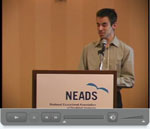
Workshops - Solutions to Library/Print Material Access
Usable Alternate Formats for Scientific Materials
Daniel Zingaro
| Video |
 |
Daniel, a visually impaired student, holds a B.Sc and M.Sc in computer science and is now working on his M.Ed at OISE with the University of Toronto. Daniel has worked as an assistive technologist, and has designed accessible computer games programmer through his own company (www.danZGames.com). He has authored a textbook, “Invariants: a Generative Approach to Programming,” to be published in 2008 by College Publications.
Abstract
Students who are visually impaired often request electronic format versions of books, to be read with screen readers or related software. Scientific materials (i.e. formulae, code, special symbols, etc.) may not work well with this available technology.
This presentation will draw from Daniel’s own experiences, to examine other formats that can be requested from authors or publishers to solve these formatting issues. He will look at how markup formats such as LaTeX differ from traditional formats such as PDF, explain their benefits and how students can learn to read these documents, and demonstrate how they can provide faster turnaround times than other electronic formats.
Files
- Daniel Zingaro : 158.08 KB
Summary
Daniel Zingaro described the process when a student requests a book in an alternate format. Often there is no money and little time before classes start, but typically there is a long wait after sending the request to the publisher to obtain the electronic format.
It is easiest and quickest for a publisher to send a PDF file, Zingaro said. Once received, the file must be converted into an accessible format. Scientific materials are particularly hard to make accessible because of their special symbols, formulas, tables, and charts.
A screen reader can directly read a PDF file loaded into Adobe Acrobat. It can sometimes be easy to navigate through tables, but no changes can be made and it is hard to search for text. An alternative is to convert the PDF file to text. Various programs can do this, including Adobe Acrobat Reader, Adobe Acrobat Professional, and Xpdf. Once the file has been converted, a student can add notes and clean up the text.
However, sometimes these programs cannot extract the text since a PDF is an image and the PDF font information may not be available. OCR software will give varying results. Typically, these programs produce many mistakes when converting scientific content.
Zingaro presented another solution. Math and related material are awkward to type using a standard word processor, he said. However, there are mark-up languages that allow authors to enter this information in a text-only format into a computer file.
LaTeX is such a language. It is commonly used, readable with screen readers or other readers, and easy to learn, Zingaro said. For example, instead of the square root symbol, the author types “sqrt,” and for fractions, the author types “frac.”
Authors of math and science books send their LaTeX files to their publishers, and the publishers use the LaTeX source code to generate the PDF files they need. This means a version of the book probably exists in LaTeX, containing a completely accessible, text-only copy of the book’s contents.
Zingaro’s experience is that computer science courses and research use material from many books, journals, and conferences. It is impossible to produce all of this material in an accessible format. His solution is to ask publishers and authors for LaTeX.

